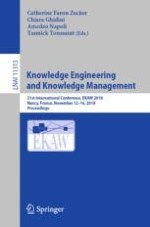This book constitutes the refereed proceedings of the 21th International Conference on Knowledge Engineering and Knowledge Management, EKAW 2018, held in Nancy, France, in November 2018. The 36 full papers presented were carefully reviewed and selected from 104 submissions. The papers cover all aspects of eliciting, acquiring, modeling, and managing knowledge, the construction of knowledge-intensive systems and services for the Semantic Web, knowledge management, e-business, natural language processing, intelligent information integration, personal digital assistance systems, and a variety of other related topics. A special focus was on "Knowledge and AI", i.e. papers describing algorithms, tools, methodologies, and applications that exploit the interplay between knowledge and Artificial Intelligence techniques, with a special emphasis on knowledge discovery.
